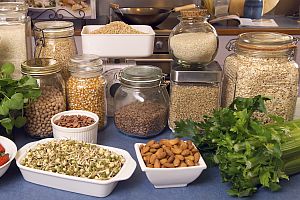Benefits of Copper
 Like some of the other essential dietary minerals, copper is needed only in trace amounts for your body to function properly. Nevertheless, copper is vital to many of the body’s functions, so it is important to ensure that you are not copper deficient (which is actually quite rare). Since the human body cannot synthesize copper on its own, it must be absorbed by the body from the food we eat.
Like some of the other essential dietary minerals, copper is needed only in trace amounts for your body to function properly. Nevertheless, copper is vital to many of the body’s functions, so it is important to ensure that you are not copper deficient (which is actually quite rare). Since the human body cannot synthesize copper on its own, it must be absorbed by the body from the food we eat.
Copper combines with protein to produce enzymes that spur a wide range of bodily functions. It plays a key role in energy production, supports the brain and central nervous system, and helps in the creation and metabolism of neurotransmitters. It also is important in the formation of connective tissue (including that of the heart and blood vessels) and plays a part in bone formation. It is necessary for proper iron metabolism and the healthy formation of red blood cells. It is also responsible for the production of melanin, the pigment that gives color to the skin, eyes and hair. Copper acts as an antioxidant and is important for a healthy immune system.
As mentioned earlier, copper deficiency is relatively uncommon. However, some people are more prone to a deficiency than others. This includes those who have cystic fibrosis, severely restricted diets, or problems with absorption through the gut (such as individuals with celiac disease). Infants and the elderly are also more prone to copper deficiency. Infants may be more at risk they have been fed only cow’s milk formula (cow’s milk is very low in copper).
The recommended daily intake of copper is as follows:
Infants, birth to 6 months: 200 mcg/day
Infants, 7 – 12 months: 220 mcg/day
Children, 1 – 3 years: 340 mcg/day
Children, 4 – 8 years: 440 mcg/day
Children, 9 – 13 years: 700 mcg/day
Adolescents, 14 – 18 years: 890 mcg/day
Adults, 19 years and older: 900 mcg/day
Pregnant women: 1,000 mcg/day
Breastfeeding women: 1,300 mcg/day
Being deficient in copper can contribute to anemia and osteoporosis as well as a variety of other health problems. However, having too much copper in your system can actually be toxic. Signs of copper toxicity include nausea, vomiting, diarrhea and abdominal pain that can eventually lead to kidney and liver failure, coma and death. Taking high amounts of zinc can lower copper levels that have become too high.
Children should get the copper they need from their diet rather than from supplements. Adults who are considering taking a copper supplement should consult with their doctor before doing so, since it is important not to get too much copper, and it must have a proper balance with zinc. Foods rich in copper include liver, nuts (particularly cashews, almonds and Brazil nuts), seeds, legumes, clams and oysters.

 It almost seems like a silly question, but it’s worth answering nonetheless. Why? Because it’s too important not to—a great many people could avoid the potentially serious health problems associated with being overweight or obese by losing the extra pounds. And the sooner the better.
It almost seems like a silly question, but it’s worth answering nonetheless. Why? Because it’s too important not to—a great many people could avoid the potentially serious health problems associated with being overweight or obese by losing the extra pounds. And the sooner the better. For many people, summertime just isn’t summertime without a barbecue! It’s a generations-old cultural phenomenon that combines three things American families love—food, family and fun!
For many people, summertime just isn’t summertime without a barbecue! It’s a generations-old cultural phenomenon that combines three things American families love—food, family and fun!

 Can eating lots of carrots really improve your eyesight? Not exactly, but carrots do contain something called provitamin A carotenoids. These are pigments found in some plants that can be converted by the body into vitamin A. And vitamin A actually is important to your vision.
Can eating lots of carrots really improve your eyesight? Not exactly, but carrots do contain something called provitamin A carotenoids. These are pigments found in some plants that can be converted by the body into vitamin A. And vitamin A actually is important to your vision.

